

Unilever and Alibaba launch AI-powered closed-loop recycling system in 'Waste Free World' initiative. Two of the globe's biggest consumer goods firms have come together to create recycling machines that use artificial intelligence (AI) to automatically identify and sort plastic packaging.
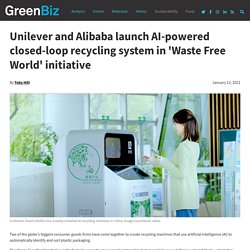
Self-driving cars could cause more pollution without dramatic changes to the grid. The world is on the cusp of dramatic changes in the ways people own, operate and power their means of transportation.
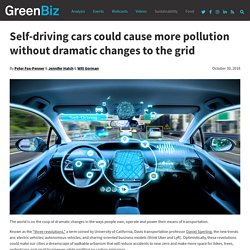
Known as the "three revolutions," a term coined by University of California, Davis transportation professor Daniel Sperling, the new trends are: electric vehicles; autonomous vehicles; and sharing-oriented business models (think Uber and Lyft). Optimistically, these revolutions could make our cities a dreamscape of walkable urbanism that will reduce accidents to near zero and make more space for bikes, trees, pedestrians and small businesses while emitting no carbon emissions. However, because these new technologies aim to dramatically reduce transportation costs, many people are concerned that more people will use autos to get around and the future will be filled with worse traffic and congestion (PDF).
That could mean that consumption of fossil fuels will increase — bad outcomes for society’s sustainability goals. "Electric" town in the desert. The Arabian Desert, once one of the most lifeless places on Earth, no longer matches that description: Come 2050, it is home to the world’s first "electric" town.
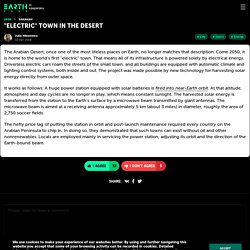
That means all of its infrastructure is powered solely by electrical energy. Driverless electric cars roam the streets of the small town, and all buildings are equipped with automatic climate and lighting control systems, both inside and out. The project was made possible by new technology for harvesting solar energy directly from outer space. It works as follows: A huge power station equipped with solar batteries is fired into near-Earth orbit. At that altitude, atmosphere and day cycles are no longer in play, which means constant sunlight.
FullNBMConference2019Proceedings. Rebound - is it undermining the circular economy dream? Those of us interested in sustainability and the circular economy are acutely aware of the multiple challenges facing our society, including climate chaos, ecological destruction, poor health, poverty and worsening inequality.
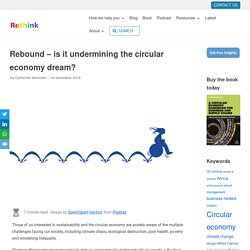
We know the circular economy aims to reduce, reuse, remake and eventually to recycle – the four ‘Rs’ of the loops. But what if there is another R – rebound – opening the door for companies to adopt circular strategies and still drive growth in consumption (and pollution and waste)? Urgent challenges. Innovative business models map. The economy of the future is circular. Here's how entrepreneurship can help. My five year old daughter asked me recently if she could take a bag and her gardening gloves to school.

I said yes, of course – but why? She replied that at recess, she had started collecting the garbage in her school yard and there was too much to carry in her hands – hence the need for a bag. DRCE. New report provides a bluebrint for circularity of PET bottles in Southeast Asia - Circular Online. GA Circular has launched a new report “Full Circle: Accelerating the circular economy for post-consumer PET bottles in Southeast Asia” in collaboration with The Coca-Cola Company.
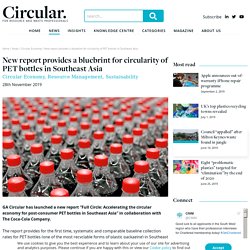
Launch of GGGI’s first Green Growth Index: Measuring Green Growth Globally — Global Green Growth Institute. On October 23, the Global Green Growth Institute (GGGI) officially launched its Green Growth Index, the first benchmarked composite index designed to track green growth performance in four dimensions of green growth.

The Index is aligned with the United Nations Sustainable Development Goals (SDGs), the Paris Agreement, and Aichi biodiversity targets, and it is the first index to benchmark green growth performance against the targets of these international agreements. Measuring green growth in 115 countries globally, the Index allows governments to align their pathway to green growth with achieving the SDGs and national climate and biodiversity goals. GGGI developed this first global Green Growth Index to show how countries perform in using and protecting natural resources for a sustainable future and in creating economic opportunities for an inclusive society. The Green Growth Index offers countries a chance to see how they are performing against common targets for green growth.
Car sharing platforms. Dominion Energy's electric school bus program offers valuable vehicle-to-grid lesson. Multiple industries have been waiting for years for commercial vehicle-to-grid (V2G) technologies to be deployed at any kind of scale.
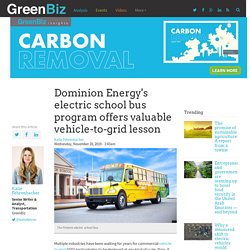
Now, it looks as if school buses could be the linchpin for the movement. A couple of months ago, southern U.S. energy giant Dominion Energy announced the largest electric school bus initiative in the nation, with plans to deploy up to 1,050 buses on the roads of Virginia over the next five years. These could be used for local grid services, as well as reduce air pollution and lower carbon emissions. The 10 Fastest Growing Green Startups in 2019.
Social entrepreneurship creates a green industry, which helps to solve environmental problems through the development of innovative solutions.

Some companies go green either to reduce environmental harm or to gain consumer support. From energy sharing and ride-sharing to commodities trading, there's no limit to the kinds of industries green startups can tackle. This article looks at the top three green startups of 2020 as listed by Cision PR Newswire. These green startups have built their businesses on a platform for a greater, greener world. Key Takeaways Green startups seek to leverage technology to create environmentally-friendly products and to encourage social good.Green startups face unique challenges in attracting the right investors and competing with traditional growth-only focused entrepreneurs.Still, some have seen great success. Green Startups 1. Supply-Change.org. Rethinking carbon for the new economy.
The following is adapted from State of Green Business 2018, published by GreenBiz in partnership with Trucost.

As the world moves toward a low-carbon economy, a fourth industrial revolution is taking place where advances in digital technology, artificial intelligence and robotics are combining to fundamentally change the way we live, work and do business. Many of these new technologies require increasing amounts of electricity, which will have to be generated from super-efficient, low-carbon sources if the world is to achieve the Paris Agreement on climate change to limit global warming to 2 degrees Celsius.
The information and communications technology (ICT) sector, where proliferating connected devices are giving rise to an internet of things, could see electricity use soar. At the same time, it is creating opportunities for more efficient energy use. For example, the global smart grid market is projected to grow from almost $21 billion in 2017 to $51 billion by 2022. Artificial intelligence gets smarter. The following is adapted from State of Green Business 2018, published by GreenBiz in partnership with Trucost.
Stephen Hawking feared it. Elon Musk begrudges it. Mark Zuckerberg embraces it. There is no shortage of smart people willing to offer their sometimes dire, sometimes optimistic opinions about how humankind's future will be reshaped by computers and software using some sort of artificial intelligence (AI). Secondhand fashion site TheRealReal soars on Wall Street debut. Shares in The RealReal, the US secondhand luxury fashion website, jumped more than 40% after their Wall Street debut as investors cashed in on the growing buzz around the circular economy in fashion. The San Francisco-based tech firm, founded by its chief executive, Julie Wainwright, argues it is making the £1tn global luxury industry more sustainable by extending the life cycle of expensive handbags and shoes beyond a season.
Make Fashion Circular Awarded £1m By People's Postcode Lottery - Circular Online. The Ellen MacArthur Foundation’s Make Fashion Circular initiative has been awarded £1 million by players of People’s Postcode Lottery, from the Dream Fund, which supports charities in bringing their dream project to life. Farfetch launches 'on-demand' donation service in circular fashion drive. The changing role of the designer in the circular economy. Late last year the World Business Council for Sustainable Development released a Practitioners Guide to the Circular Economy highlighting design as the stage with the most opportunity for circular thinking - rather than procurement, manufacturing, use, disposal, etc. Add to that the stratospheric rise of design thinking as a strategic business process and it begins to feel like design is on-the-up.
This was front-of-mind as I joined a panel at Forum for the Future’s Circular Drinks - debating ‘the changing role of the designer in a circular economy’, with Industrial Design guru Rupert Wylie and Forum’s circular economy lead, Martin Hunt. Though I trained as a product designer many moons ago and have worked on sustainability, design and innovation ever since, my overriding feeling is that the design world has been slow to grasp the full opportunities, and risks that sustainability presents.
Researchers turn plastic water bottles into prosthetic limbs. Artificial limbs made out of plastic water bottles could save healthcare providers millions of pounds and help tackle pollution at the same time. An expert at De Montfort University Leicester (DMU) has successfully manufactured the first-of-its-kind prosthetic limb socket made from recycled plastic bottles. Dr K Kandan, senior lecturer in Mechanical Engineering at DMU, found he could grind the plastic bottles down and use the granulated material to spin polyester yarns, which can then be heated up to form a solid yet lightweight material that can be moulded into prosthetic limbs.
Latvian companies develop “AI-based” deposit-refund system for plastics. “Green” roads made using plastic waste set for new Bristol development. Sustaining roads with grape and agricultural waste. Our wooden future: making cars, skyscrapers and even lasers from wood. Pioneering sorting technology: HolyGrail project moves towards a circular economy - Packaging Europe. “Disruptive” tag & trace recycling technology launches. Waste processing. Novel Direct Thermal Charging Cell Converts low-grade waste heat to usable electricity. Dr Tony Shien-Ping Feng of the Department of Mechanical Engineering at the University of Hong Kong (HKU) and his team invented a Direct Thermal Charging Cell (DTCC) which can effectively convert heat to electricity, creating a huge potential to reduce greenhouse effects by capturing exhaust heat and cutting down primary energy wastage. New route to carbon-neutral fuels from carbon dioxide. Producing protein batteries for safer, environmentally friendly power storage.
Proteins are good for building muscle, but their building blocks also might be helpful for building sustainable organic batteries that could someday be a viable substitute for conventional lithium-ion batteries, without their safety and environmental concerns. Bioplastic made from fish waste wins James Dyson Award. Dutch businesses work to test concept of circular economy.
Why the soft machine will dominate urban transport. Here are the cities that are leading in electrifying transportation. 7 urban air mobility companies to watch. Energy storage charges forward. Enter the electrification of everything. Movers & Shakers: Cathrine Barth on why Norway has what it takes to go circular - The Explorer. Circular economy: Norwegian technology promotes sustainable use of natural resources - The Explorer. Massive wind turbines and microplastic weather forecasts: The best green innovations of the week. Home - BusinessGreen Leaders Summit 2019. Horizon scanning: Nine innovations set to shake-up sustainability in 2019.